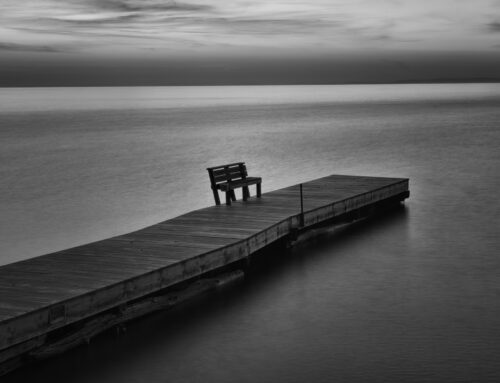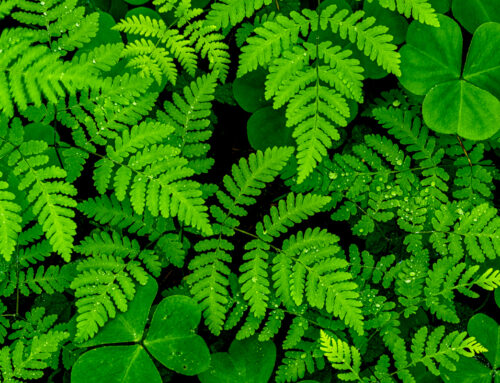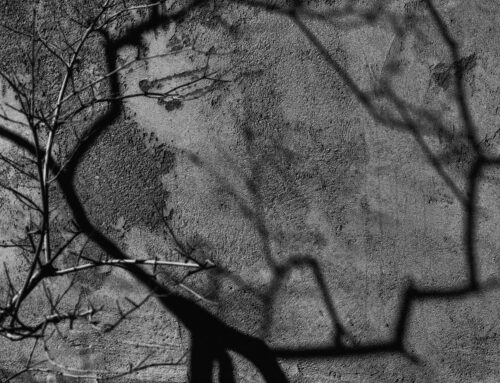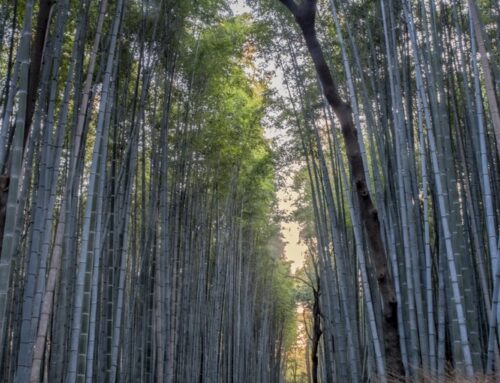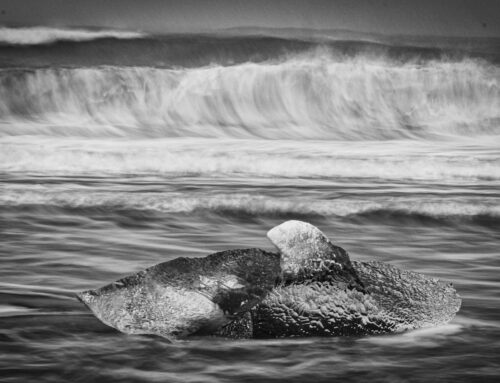This is a revised edition of a previous article I did on the Palouse about 6 years ago. I hope it helps when photographing this amazing location!
With over 6,000 miles of rolling hills of wheat, barley, lentils and canola, the addition of spring wildflowers and dusty country roads punctuated with 100+ year old barns, photographing the Palouse is a photographer’s paradise. The subject matter is endless.
The “Palouse” area is in Southeastern Washington and is accessed by flying into Spokane (1 ½ hrs. north) or driving a few hours from Seattle, Washington or Portland, Oregon. The major towns are Pullman, home of Washington State University and Moscow Idaho, home of the University of Idaho. The Palouse is remote. It’s not a tourist destination, but during the spring and summer there are usually many photographers.
Here are a few interesting facts about the Palouse
- This area averages 100-200 bushels of wheat per year.
- The Palouse is the largest producer of lentils in the world.
- Because of the geography, the crops of the Palouse region require no irrigation.

Each season brings different photographic opportunities. Most photographers visit the Palouse from mid-May through September. In the springtime, endless, rolling fields of different shades of green abound. Early to late June the patterns of the green fields along with the red barns make for a truly remarkable photographic experience.
By August the harvest is in full force. This is the best time to capture the clouds of dust, created by the combines in the field in the late afternoon. The setting sun provides warm glows over the vastness of the fields of the Palouse. The clouds over the Palouse can be amazing in any season. Billowing white clouds appear to indicate summer thunderstorms. Sunsets and sunrises can be spectacular during these times. By fall the many of the fields are different shades of brown dirt with patterns inscribed by the tractors during and after the harvest.
The Palouse is a great area to work on photographic skills. It often takes a day in the field to get your eye and mind going to be successful in this area. One must take light and patterns into consideration more than anywhere else. Images that portray depth, surprise and drama, while using leading lines, foregrounds and other graphic elements will produce some great images.
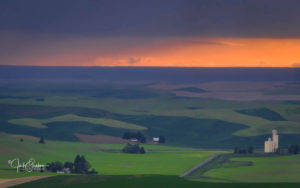 GETTING TO THE PALOUSE
GETTING TO THE PALOUSE
The Palouse is located between the Columbia River Gorge and Glacier National Park. You can fly into Portland or Seattle (about a 5 ½ drive to Colfax). Many folks fly into Spokane and drive about 1 ½ hrs. south on Hwy 195.
If it’s your first time to the Palouse, I will warn you: photography in this area isn’t as easy as you may think. The Palouse is an area most people have never been to. There are no icons like many of our National Parks. Most areas in the Palouse are unrecognizable to people unless they have visited the region previously. Therefore, stressing vision and creativity during your time in the Palouse is primary. Almost without exception, each location you visit will be different from the prior location.
To say the Palouse is spacious is an understatement. Unlike anywhere else in the United States, other than perhaps Death Valley, does space become as intimidating as here. In addition, texture and patterns create so many photographic opportunities, one must be very selective.
Here are a few hints that I follow myself that will help you make some interesting images:
- I always try to find a foreground-–mainly because of the vastness.
- I am always looking for depth in an image using a wide angle lens. Understanding hyperfocal length is necessary to get the depth of field you want. You must get low when using wide angle lenses in order to get the correct depth and angle you need for a dramatic image.
- PRS—–I always look for Patterns, Repetition and Simplicity
- Again because of the expanse, you need to pay attention to your backgrounds and other distractions and make sure they do not take away from the scene.
- Here in the Palouse the use of colors can be rewarding. Red barns, in green fields are a great use of complimentary colors. Conversely, Monochrome can add a great amount of drama when used properly.
- Exposures can be tricky because of the dramatic, ever changing and sometimes contrasting light. The light always seems to move over the Palouse region and changes constantly. Using graduated Neutral Density filters can compensate for quite common lighting difficulties. (See Filters… under My Gear)
- Slow Down! Unless you are just lucky enough to get out of your vehicle and hit on some dramatic light, take your time and bond with your surroundings. I guarantee that unless you’ve been to the Palouse a few times already, you will be overwhelmed with its inert beauty. Rushing to make photographs will result in mediocre results. Decide what strikes your eye or what is perhaps creating dramatic detail. Understand where we are, appreciate the inert beauty and slow down, take it all in. By doing this I can guarantee that you’ll come away with great images.
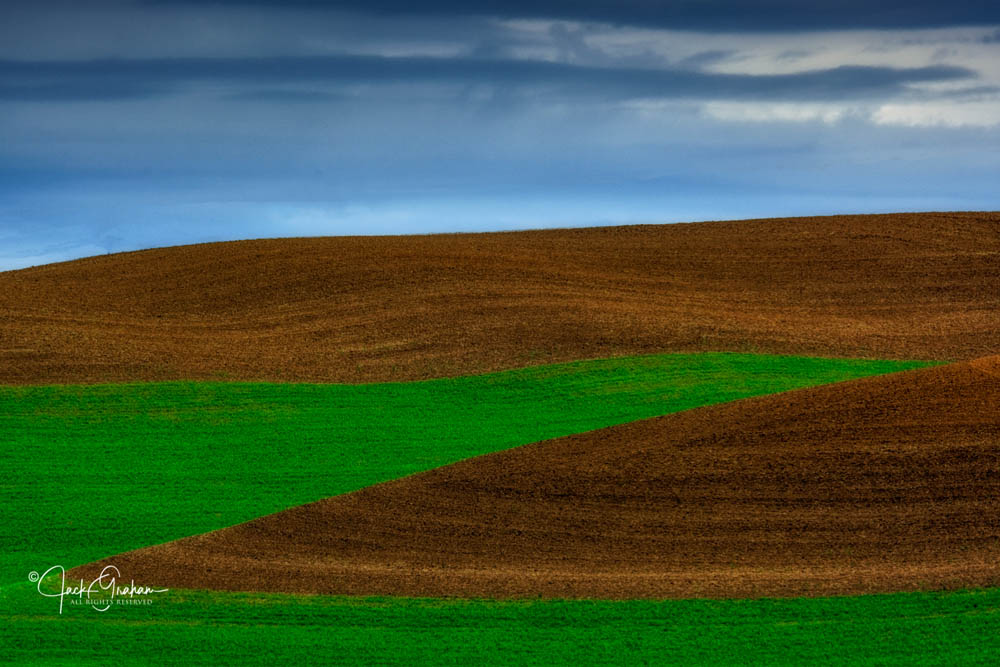
RECOMMENDED PHOTOGRAPHIC EQUIPMENT FOR THE PALOUSE
- CAMERA: I carry two camera bodies, just in case.
- TRIPOD: in the words of my dear friend Bill Fortney “There are two kinds of tripods, ones that are easy to carry, and good ones.” It can get very windy on the bluffs. A sturdy tripod and head are a necessary addition to your arsenal.
- LENSES: I use lenses from 17mm to 400mm. A 400 comes in handy when shooting the folds of the Palouse from locations that look down on the landscape such as Steptoe Butte. A teleconverter can come in handy as well.
Wide angle lenses can tell the story of the expansive landscape. Think foregrounds if at all possible when using wide angle lenses close to the ground (refer to my article on the proper use of wide angle lenses by clicking HERE. I suggest a small aperture to attain the best depth of field.
Long lenses are great to compress the hill sides, or folds as they appear from locations such as Steptoe Butte. - FILTERS. I recommend a Polarizer as well as graduated ND filters. I use GRADUATED ND filters made by Breakthrough Photography. They are the ones many of my fellow professional photographers are now using. There is NO color shift and they are made of the best glass available.
- CABLE RELEASES and LENS HOODS. Should always be used!
- DUST PROTECTION: Dust on the many unpaved roads in The Palouse can be a real problem. Consider changing lenses inside your vehicle. A handheld blower is useful. I also use a good VERY soft cloth from 3M to keep my lenses dry.
HINT: DO NOT wipe your lenses with cloths before first blowing the dust off with a blower. If you do, you’ll probably scratch your glass as the dust particles and often dirt accumulates easily on the front of lenses.
I do not use micro-fiber cloths—they tend to only move water and dirt around, not absorb it. I use these cloths made by 3M (they are made for auto detailing but are amazing.) You can wash them (no soap) and they stay like new. Click HERE to purchase them. - PHOTOGRAPHY TIP: Clean your windshields. Pack some windshield washer, or cleaner and paper towels. You’ll need them to remove dust and bugs from your windshield. This will help you see as you drive.
(See more of my choices for photography equipment HERE)
 PALOUSE WEATHER
PALOUSE WEATHER
I have been in the Palouse during years of hot cloudless skies and some just the opposite. We always hope for the latter. Days of all-day rain are rare from June through August. As the summer progresses, rainfall becomes less and less. Mid October can bring some much-needed precipitation. However, rain and cold fronts can produce some amazing conditions. Rainbows are common during days of rain showers. Dark, lightning filled skies on top of Steptoe Butte produces dramatic imagery. Cloud formations can be so amazing they sometimes detract from the subject at hand! My basic credo for using skies in images is that if the sky doesn’t lend anything to the image, leave it out, or cut it to a minimum.
I use Accuweather a lot to predict the weather. They seem the most accurate. I-Phone Apps like ‘Storm Radar” by the Weather Channel is also really a good one. Be aware of the temperatures projections before you set out for the Palouse. It can be very cold and windy in certain locations and warm in others. Be prepared.
MAKING THE BEST USE OF YOUR TIME
I would plan on at least 4 or 5 days in the area. The best time for photography, like in many other areas, is during the golden hour at sunrise and sunset. In June, sunset is early. You need to be at your location, ready to shoot at least 40 minutes or earlier than sunset. The very best light is usually 30-40 minutes before sunrise and 30-45 minutes after sunset and sometimes longer. You can check the angle of the sun by using the Photographers Ephemeris.
During the daytime I would take some time to relax and recharge as well as to review your images. Late mornings and midday, when clear, is also a good time to wander some of the small towns like Oaksdale, Garfield and Palouse in search of some interesting photographs of old buildings, churches, old rusted vehicles, grain silos and other relics of the past.
Another good use of this time is to take time to scout locations for sunrise and sunset photography. Summer days are long ones. Be sure to get plenty of rest.
MONOCHROME PHOTOGRAPHY … Why Monochrome?
Monochrome photography moves away from reality. If one wants to move away from reality in photography, then monochrome is for you! When making monochrome images I enjoy this departure. Monochrome photography has more visual depth. Monochrome photography is how we see the world around us in differences of luminance (light & light contrast).
This means that using one color, the color gray for example, the differences between luminance values become clearly visible in a way that is almost impossible in color. The visual distractions of different hues and saturation in color make it very difficult to see differences in luminance. This is important because it’s through differences of luminance that we can perceive depth and create depth by adjusting the luminance values or light contrasts.
Colors (only hue and saturation) can’t create depth, it’s the luminance element of color that creates depth, along with the depth created by using perspective lines.
Though the Palouse is very colorful in the spring and summer sometime thinking in monochrome can produce some interesting images with very different feelings. Consider making some monochrome images while here.
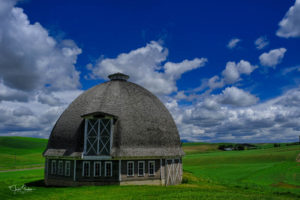 GETTING AROUND IN THE PALOUSE
GETTING AROUND IN THE PALOUSE
Get a good map. Highways 26 and 12 are the major East-West roads. Highways 27 & 195 are the major North-South roads with many off shoots on each, containing lots of subject matter to photograph.
There are four kinds of roads in the Palouse:
- The paved roads. These are usually busier and have fewer pullovers. Be very careful. They are obviously easier to drive, most of the good locations are on the unpaved roads.
- Gravel Roads. Many farmers have gravel on the roads leading to their driveways. The gravel usually ends shortly after that.
- Primitive Roads. These are marked as such. Be very careful when wet. I would stay off these when wet. The mud is as slippery as ice and sinking into the mud is common.
- Seasonal Roads, typically open only from April-October. These are the same as Primitive roads but worse. They can have huge potholes, dips and conditions that only high clearance four-wheel drive vehicles are safe in. BEWARE!
BASE OF OPERATIONS
The largest “big town” is Pullman, the home of Washington State University. I have found Colfax, WA to be a good base of operations as it’s centrally located. There are a few hotels in town (I stay at the Siesta Inn…good rates, clean, and friendly: 509-6397-341). The towns of Steptoe, Palouse, Pullman, and Oakesdale are only a short drive. There’s lots to photograph within a 45- minute to one-hour radius of Colfax.
PHOTOGRAPHIC LOCATIONS
I have been running workshops in this area for many years now. I have lots of “secret” locations that I like to go to. I share these with my workshop attendees. However, you can read about a few of the more interesting locations by subscribing to the PHOTOGRAPH AMERICA NEWSLETTER. Issue # 54 is about the Palouse.
 SOME OF MY MUST-SEE LOCATIONS not in order of importance. (NOT MY SECRET ONES!)
SOME OF MY MUST-SEE LOCATIONS not in order of importance. (NOT MY SECRET ONES!)
Steptoe Butte: You can have great sunsets here, but beware, get there early. Every year like many other locations it gets crowded earlier and earlier. Also, the shadows in the landscape, produced by the rolling hillsides appear about 1 hour before actual sunset. Sunrises can be interesting. The light is much different and appears in prime about 30-45 minutes after sunrise in June. Often crop dusters and hand gliders are there for added interest. From the top you have a 360-degree view of the Palouse. I like to photograph about 3/ 43 the way up (right look for my taste) near a big cell and communications tower.
Dahman Barn, Uniondale. This barn, built in 1953, is famous for its fences which are comprised of over 1,000 wagon wheels. Please also visit the Artisans at the Dahmen Barn.
These are a group of consignment artists who have lots of great art to be seen. There is also a great gift shop there as well.
Palouse, Garfield, Oaksdale…main streets. These town are much like they were 30 or more years ago. There is some great photography in and around all of them. The old flour mill in Oaksdale is a must see.
Weber House: This is an old abandoned house built in the late 1800’s a few miles south of Pullman at the intersection of Weber and Whitman road. Driving to the south from Pullman (Hwy 195) make a left turn on Chambers Road, then another left on Johnson Rd. Drive to Weber road then turn right onto Weber Rd. When you turn right onto Whitman and you’ll arrive at the house. I met the owners this year, nice folks. They filled us in on the history of the place (It was almost demolished, but they managed to save it!). These folks live right around the corner and monitor the photographers. They love having the house photographed, but only from the road. Please do not abuse their kindness. Stay on the road. Do not enter the property.
Palouse Falls: I typically don’t take my attendees here. Its about a 1 ½ hour drive from Colfax. That’s 3 hours round trip. We typically can visit 2-3 location in that time. I do encourage my attendees to visit the falls on the way home. (Off Hwy 26 on the way to Walla Walla.)
Just get in your vehicle and roam, look for the patterns and textures. You’ll find all of that and more. Enjoy the Palouse!
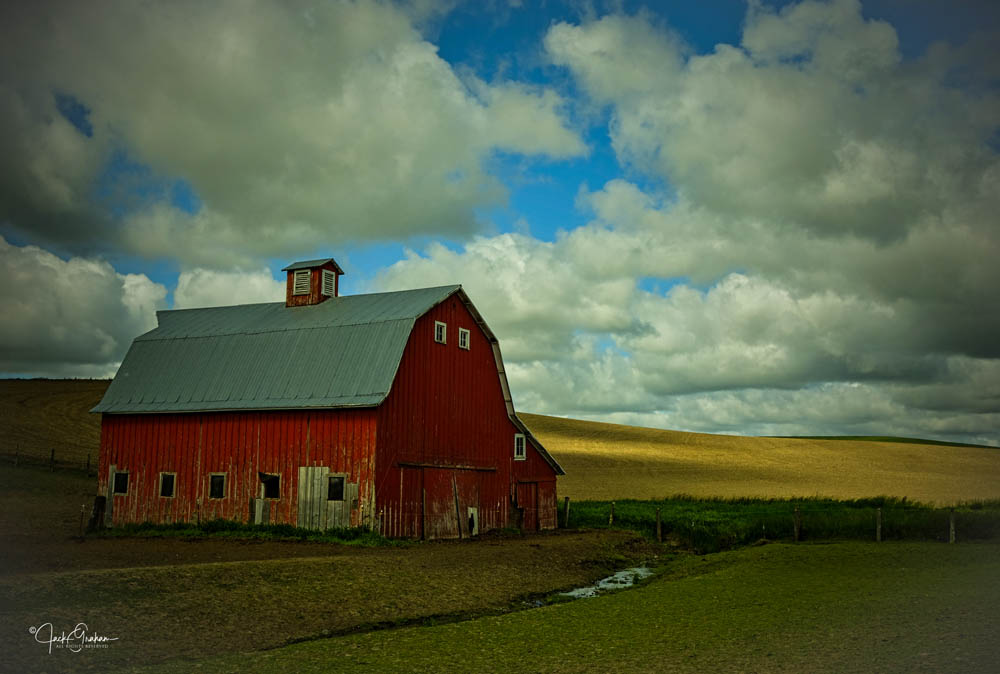
THINGS ARE CHANGING IN THE PALOUSE
Every year new workshop leaders appear in the Palouse. As interest spreads through social media, more and more photographers are visiting this region. Along with this inevitably comes folks who take advantage of the land and trespass on farmers land without asking. This gives us, who do the right thing, a bad name. In Washington one does not need to post a No Trespassing sign to indicate that walking onto their land is trespassing. Please respect their property and ring the doorbell and ask. More often or not the farmers will allow you to photograph their barns, etc. Please consider staying off the fields and not trample their crops. Many farmers who used to allow access are not allowing access anymore due to the lack of respect by others. A few landmarks are now off limits. Please consider this when visiting.
All images made using the FUJIFILM “X” Camera System (X-T3 and X-H1) along with FUJINON Lenses. Jack is a FUJIFILM “X “Photographer.


